You might have heard the news about Universal tasked a visual effect company, Weta Digital, to get Paul Walker into the Furious 7 after the star's passing. Now, with the assistance of AI, you can also put your face onto a photo or video you want. You don't even need programming skills to create a deepfake video.
In the early stages, the technology needed for creating deepfake videos was expensive. However, nowadays, you can find tools to make deepfake video for a fraction of the cost or even for free. Before getting into the step-by-step process of creating deepfake videos, you should know the definition and use cases.
In this article
Part 1. What Are Deepfake Videos Used For?
According to Cambridge, a deepfake is a video or sound recording that replaces someone's face or voice with that of someone else in a way that appears real.
Thanks to AI development and machine learning, people can create deepfake videos faster and cheaper. Creating deepfake videos allows people to combine pictures and videos to show a scene that never happened.
Many sectors use deepfake videos, including entertainment, film and advertising, and social media.
1. Entertainment
The technology to create deepfake videos is often used in the entertainment industry. Deepfake technology can be used to synthesize someone's voice. For example, actor Val Kilmer lost his voice because of cancer in 2015. However, thanks to Sonantic's technology, Kilmer could speak once again, bringing his son to tears.
2. Overcoming Language Barrier
Deepfake videos can also be used to overcome language barriers. David Beckham used deepfake technology for his Malaria No More Campaign. He used the technology so his message can be delivered in nine different languages.
Culture and entertainment go hand in hand. Not only for entertainment, deepfake videos can also be used to enrich the cultural awareness of its audience. Dalí Museum brings back Salvador Dalí to life with deepfake technology. It allows the visitors to interact with the famous surrealist painter. Another example is how Samsung's AI lab managed to bring Mona Lisa to life with deepfake technology.
3. Education
Not limited to the entertainment indsutry, deepfake videos can also be used in the classrooms. With deepfake technology, teachers can make interactive lessons. For example, a teacher can create synthetic videos of historical figures with the help of AI. It can increase engagement from the students.
4. Film
The average budget for CGI in Avengers movies is US$350 million per movie, at the least. With deepfake technology, filmmakers can cut the cost of CGI. It shows the biggest benefit of deepfake technology in the filmmaking industry: democratizing VFX technology.
Aside from cutting the cost of VFX, the emergence of deepfake technology also allows filmmakers to craft scenes with late celebrities, just like Universal did with Paul Walker. In the case of actors who can no longer participate in the shooting process, deepfake technology can help filmmakers to still recreate the scenes without the actors’ presence. Moreover, deepfake technology can also help in reimagining actors at a younger or older age.
5. Advertising
Brands usually need to spend thousands or even millions of dollars to create an ad suitable for their brands. However, with deepfake technology, the process of creating advertisements can become significantly more cost-effective. Traditional advertisement production involves hiring actors, setting up sets, shooting multiple takes, and post-production editing, all of which require substantial time and financial investment.
Deepfake technology, on the other hand, allows advertisers to create and manipulate content digitally without the need for extensive physical production. By using deep learning algorithms, advertisers can integrate products into existing footage or create entirely synthetic scenes with actors that never existed in reality.
6. Social Media
Content creators and livestreamers are also using deepfake technology. MIT's report shows the number of Chinese influencers who use deepfakes to stream longer is increasing.
A streamer on LiveMe, Alanna Relforth, said she was both wary and curious about AI. She believed that as a streamer, creating content was her duty. She cannot simply delegate the task to AI. However, she also thinks that learning new technology is important. After all, being able to adjust to the changing landscape can help to get ahead of competitors.
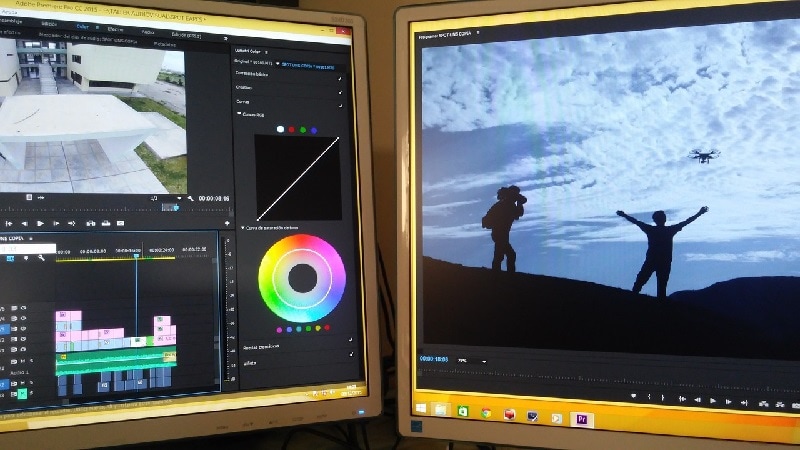
Part 2. How To Make a Deepfake Video
If you are interested in making deepfake videos, you can find tools on the internet. Some of them has free trail (but with many limitations), such as MioCreate, while some others are premium but with excellent effect, like FaceHub.
How to make Deep fake video by FaceHub [Cost-effective but Powerful]
If you are willing to pay for a face-swapping AI tool to get a better result, FaceHub is the right one for you. FaceHub has an AI toolkit so you can edit images and swap faces easily.
FaceHub offers four services:
- AI Image Generator
- AI Video Generator
- AI Anime
- AI Portrait
What you can make with FaceHub:
- Face Swap
- Digital Doubles
- Impersonations
- Digital Avatars
- Simulate the aging process
Here is the guide on how to use FaceHub to make a deepfake video:
- Step 1. Visit FaceHub's official website and click the "Get Started Now" button.
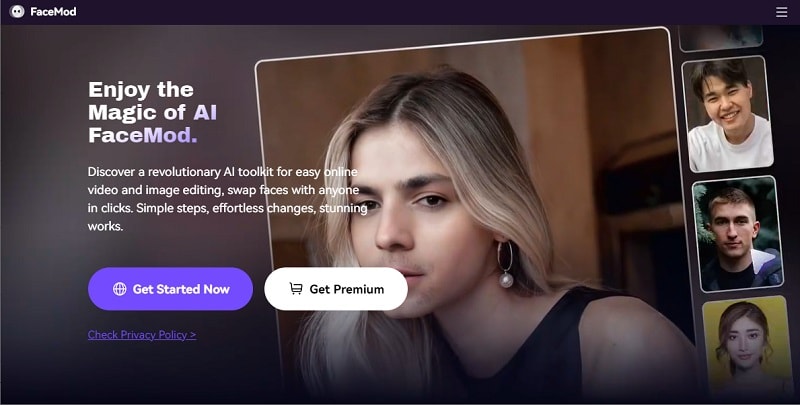
- Step 2. Upload the source video and click Next. For the best result, you should use video with good lighting. The video's duration should not be more than five minutes, with a size of 500 MB at maximum.
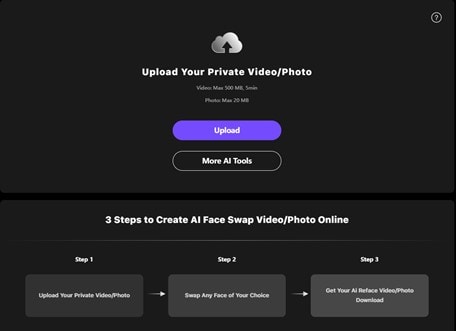
- Step 3. Upload or select the face to put on the source video.
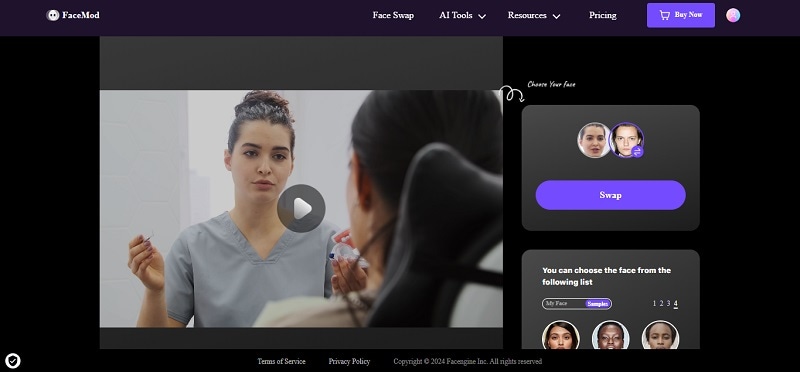
- Step 4. Check and review the resulting video. If it is to your satisfaction, you can click the save button and share it.
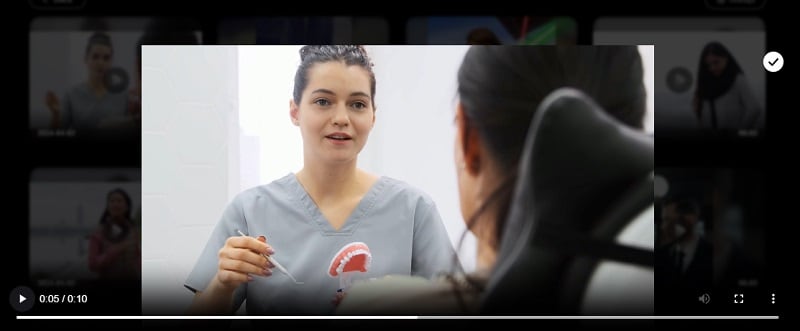
How To Make a Deepfake Video for Free [Many Limitations]
If you are looking for a tool tocreate deepfake videos online for free, MioCreate is an option for you. To use MioCreate's services, you need to follow the steps below:
- Step 1: Go to the MioCreate website.
How to deepfake a video free using MioCreate is simple. On MioCreate's website, you need to pick the "Video Swap Face" feature.
- Step 2: Upload the video you want to face-swap with.
Upload an original video or try the random video feature offered by the tool. After that, upload the target face. The target face is the face you want to put on the video.
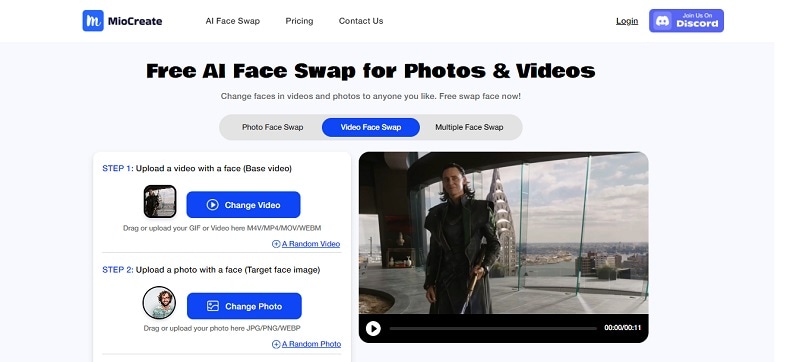
- Step 3: Start face swapping.
Once everything is ready, all you need to do is click the "Swap Face Now" button. If you want to get the HD version of the swap video, you need to upgrade your membership to VIP.
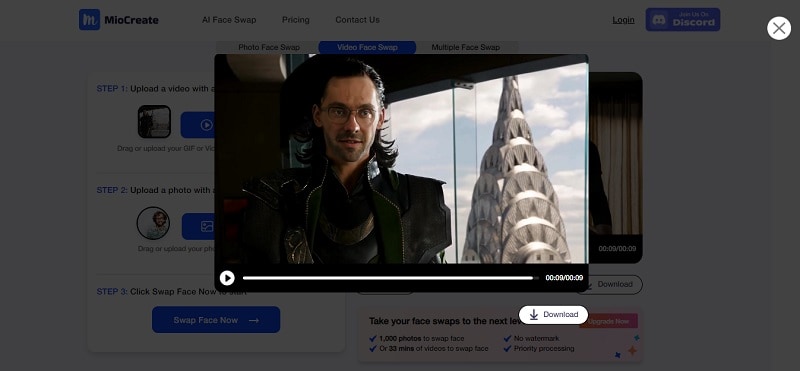
If you want to know how to make a deepfake video for free, MioCreate is a good tool. But, it has its limitations. For one, it has a watermark. Then, only VIP members can use it for longer videos. You also need to subscribe to face swap with multiple faces, so we still recommend you to try FaceHub.
Part 3. Challenges to Make Deepfake Videos
Thanks to AI, the process of making deepfake videos is quite simple. However, it does not mean that the technology is already perfect.
When trying to make a realistic depiction of a person, deepfake technology sometimes stumbles on uncanny valley instead. In this case, the result will look like humans but not realistic enough that it evokes a strong emotional response in the audience.
This problem usually can be found on free tools. That is why, if you are serious about making a face swap video, you better invest in premium tools.
Discussion: Are Deepfake Videos Dangerous?
If it’s used correctly, deepfake technology offers many benefits. However, this new technology is like a double-edged sword. Since deepfake technology can fabricate false events, people can use deepfake videos to defame someone or to spread misinformation.
And because deepfake technology can create false documents, criminals might misuse it for identity theft and fraud. Harmful deepfake videos containing violence or explicit sexual activities can also be used to harass others.
However, governments in many countries have started to realize the danger of deepfake content. As such, they have created laws regarding this new technology. That is why even though tools to create deepfake videos are easy to find, you should use them responsibly.
Conclusion
You can make deepfake videos easily, nowadays. You can even find free tools to do so. But, picking the right tool is important in ensuring the result does not look weird. Sometimes, it is better to invest in a premium tool, like FaceHub, which offers better results than using free tools.
Just like any other new technology, deepfake technology can be used for good or bad. Mostly, people want to make deepfake videos for fun or to visualize their ideas. However, criminals can use deepfake technology for various purposes, from defamation and information to identity theft and fraud.
Thankfully, many countries have already begun to create laws and regulations for deepfake content. And that is why it is important to follow laws and ethics when creating deepfake videos.
Grammarly
Hemmingway
Plagiarism


